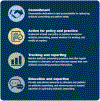Advances in optimizing the prescription of antibiotics in outpatient settings
- PMID: 30420401
- PMCID: PMC6511972
- DOI: 10.1136/bmj.k3047
Advances in optimizing the prescription of antibiotics in outpatient settings
Abstract
The inappropriate use of antibiotics can increase the likelihood of antibiotic resistance and adverse events. In the United States, nearly a third of antibiotic prescriptions in outpatient settings are unnecessary, and the selection of antibiotics and duration of treatment are also often inappropriate. Evidence shows that antibiotic prescribing is influenced by psychosocial factors, including lack of accountability, perceived patient expectations, clinician workload, and habit. A varied and growing body of evidence, including meta-analyses and randomized controlled trials, has evaluated interventions to optimize the use of antibiotics. Interventions informed by behavioral science-such as communication skills training, audit and feedback with peer comparison, public commitment posters, and accountable justification-have been associated with improved antibiotic prescribing. In addition, delayed prescribing, active monitoring, and the use of diagnostics are guideline recommended practices that improve antibiotic use for some conditions. In 2016, the Centers for Disease Control and Prevention released the Core Elements of Outpatient Antibiotic Stewardship, which provides a framework for implementing these interventions in outpatient settings. This review summarizes the varied evidence on drivers of inappropriate prescription of antibiotics in outpatient settings and potential interventions to improve their use in such settings.
Published by the BMJ Publishing Group Limited. For permission to use (where not already granted under a licence) please go to http://group.bmj.com/group/rights-licensing/permissions.
Conflict of interest statement
Competing interests: We have read and understood BMJ policy on declaration of interests and declare that we have no competing interests.
Figures
References
-
- World Health Organization. WHO Antimicrobial Resistance Global Report on Surveillance: World Health Organization, 2014. http://www.who.int/drugresistance/documents/surveillancereport/en/.
-
- Public Health England. English surveillance programme for antimicrobial utilisation and resistance (ESPAUR) Report 2014: Public Health England, 2014. https://www.gov.uk/government/uploads/system/uploads/attachment_data/fil....
-
- Centers for Disease Control and Prevention. Outpatient Antibiotic Prescriptions — United States, 2015. Atlanta, GA: US Department of Health and Human Services, CDC, 2015. https://www.cdc.gov/antibiotic-use/community/pdfs/Annual-Report-2015.pdf.
Publication types
MeSH terms
Substances
Grants and funding
LinkOut - more resources
Full Text Sources
Medical


